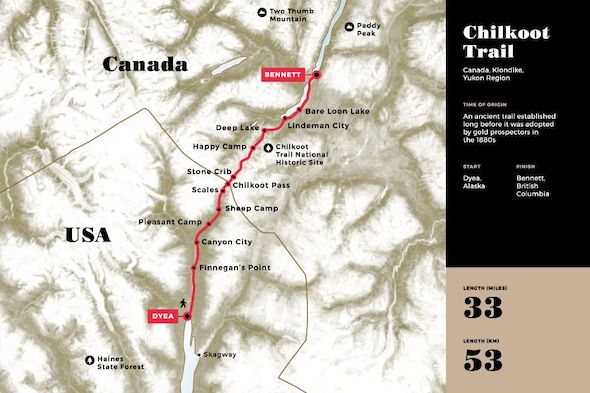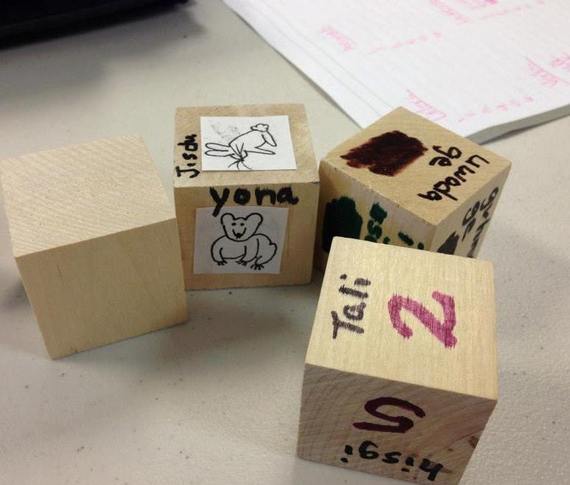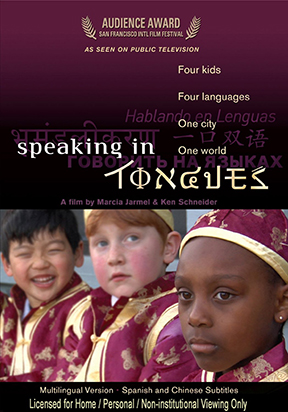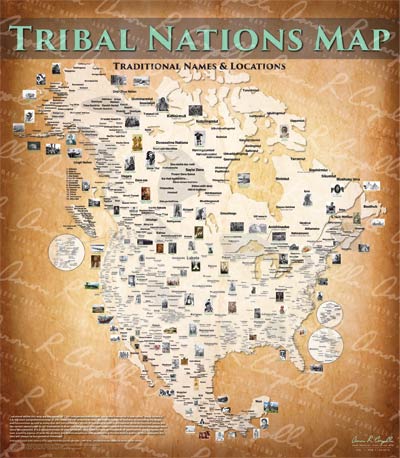October 28, 2019 - 1:50 PM | by Our Mother Tongues
Humans have been following some of the same walking and hunting trails for thousands of years. Have you ever stopped to think about which of them are the oldest?
We did research to finding the oldest trails in the world and narrowed them down our eight favorite. What makes them our favorite? We were looking for the right combination of age, interesting locations, and historical importance, as well as geographic diversity.
Check out this beautiful map of the Chilkoot Trail
The Chilkoot Trail is a through-way protected for centuries by the native Tlingit tribe. Finally discovered by gold prospectors in the 1880s, this trail offered a shorter, direct route to the Canadian interior where the gold rush was booming. Ready to risk everything in their search for gold, these men braved the more precarious, steep mountain pass taking along with them one TON of supplies. It was a necessity for surviving the treacherous terrain and the frighteningly cold Canadian winters. What would you do for a Klondike Bar (of gold)?
» Visit the original article and scroll down to Map #6
» Learn more about the Chilkoot Trail and its history

January 24, 2015 - 11:40 AM | by Our Mother Tongues
In a remix of their 2013, Valentine’s Day video, the 1491s have compiled an impressive collection of indigenous language “I Love You’s” in their video “Love Words From Turtle Island.”
The video was created with hundreds of submissions from across Indian country and includes “I Love You” in languages like Arikara, Laguna, Mohawk, Lakota, Cherokee, Choctaw and many more.
“We asked people to send us a video of them saying, ‘I Love You’ in their Indigenous language. Hundreds of submissions later from all across Turtle Island, this is the end result,” says the video description.
So grab a loved one and sit down to watch some Valentine’s Day love… Native-style.
Read the article on the Indian Country Today Media Network
November 6, 2014 - 12:24 PM | by Our Mother Tongues
by Colleen M. Fitzgerald
Professor of Linguistics and Director of the Native American Languages Lab at The University of Texas at Arlington
Originally in the Huffington Post

People are posting videos where they take on dramatic challenges and tag others to join in. It's an energetic effort to raise awareness...to use Native American languages. The 2014 Indigenous Language Challenge is on. Comedian Tonia Jo Hall, a Lakota teacher in training, posted a video of her young daughter singing in Lakota. "Whatever your native language is, we challenge you to post a 10-15 sec video no matter what it is as long as you're speaking your language," Hall wrote. She's not the only Native American language activist, learner, or teacher to promote indigenous language use via social media video challenges.
Many of these videos come from adults who are second language learners. For many years, government-run boarding schools in both the U.S. and Canada took children from Native families. This had an immense effect on Native language acquisition. Children lost priceless years of daily home environments with parents and grandparents communicating to them in their language. Home is where children's language development thrives and grows, and where children acquire the many different speech forms that express the human experience. What gets lost? So much, from the everyday language of instructions, telling jokes, or a recipe, to the ritual language of prayers, ceremonial speeches, or sharing stories of the ancestors. For too many families, the home language shifted to English, to the detriment of Native American language and culture. Educational policies were one of the factors that accelerated shift to English, resulting in Native languages becoming endangered languages.
Read the complete article in the Huffington Post
October 31, 2014 - 7:00 AM | by Our Mother Tongues
by Colleen M. Fitzgerald
Professor of Linguistics and Director of the Native American Languages Lab at The University of Texas at Arlington
Originally in the Huffington Post
Language and Native Americans are in the news as media outlets around the nation announce that they will no longer use the "R" word in conjunction with Washington's NFL franchise.
They join a groundswell of public opinion against the current mascot, ranging from #NotYourMascot activism on Twitter to the U.S. Patent and Trademark Office canceling the team's trademarks for being "disparaging to Native Americans."
But this isn't the only fight out there with Native American languages at the forefront. Two bipartisan bills are under consideration in Congress: the Native Language Immersion Student Achievement Act (H.R.4214/S.1948) and the Native American Languages Reauthorization Act of 2014 (H.R.726/S.2299). If passed, the bills will profoundly impact on the revitalization of Native American languages and the education of Native American youth.
Urgent action is needed. These two bills provide key financial and legislative support for Native American language revitalization. Not a single Native American language is deemed "safe" for survival according to UNESCO's Atlas of World Languages in Danger.
President Obama has joined the chorus supporting Native American languages. On his recent trip to the Standing Rock Sioux Reservation, Lakota Language Nest immersion students sang the Lakota Flag Song to him. Lakota is one of 11 Native American languages in the best possible category for continuance -- UNESCO puts it in the "vulnerable" category. The remaining 180 languages are in even greater states of endangerment.
Read the complete article in the Huffington Post
October 30, 2014 - 1:13 PM | by Our Mother Tongues
 San Francisco, CA. PatchWorks Films is pleased to announce the home video release of Speaking in Tongues, their award-winning documentary about dual-language education and its broader social impact (watch the trailer at: www.speakingintonguesfilm.info). Speaking in Tongues follows four diverse students who spend most of their day learning in a "foreign" language. As they grow in skill and proficiency, we see how knowing two languages changes them, their families, their communities, and their world.
San Francisco, CA. PatchWorks Films is pleased to announce the home video release of Speaking in Tongues, their award-winning documentary about dual-language education and its broader social impact (watch the trailer at: www.speakingintonguesfilm.info). Speaking in Tongues follows four diverse students who spend most of their day learning in a "foreign" language. As they grow in skill and proficiency, we see how knowing two languages changes them, their families, their communities, and their world.
Speaking in Tongues showcases a world where language barriers are being addressed in San Francisco public schools on a daily basis. Durell, an African-American boy from public housing, learns to read, write, and speak Mandarin. Jason, a Mexican-American boy, whose parents are not literate in any language, develops academic Spanish while mastering English. Kelly, a Chinese-American girl, regains her grandparents’ mother tongue—a language her parents lost through assimilation. Julian, a Caucasian teen, travels to Beijing to stay with a Mandarin speaking host family and test his fluency. Together, these students’ stories reveal the promise of a multilingual America. Each kid’s world opens up when they start learning two languages on the first day of kindergarten, and we see them develop both bicultural and bilingual fluency.
Speaking in Tongues is a must for anyone interested in America’s role in our interdependent world. Business leaders point to a “flattening” world, seeking workers with multilingual skills like those displayed by many from rising nations; the Department of Defense pours hundreds of millions of dollars into teaching; languages deemed “strategic” to national security (today Mandarin, Arabic, Russian. Tomorrow, Hindi? Portuguese? Malay?); and many educators tout the improved test scores of bilingual children—whether they speak English as a first language or not.
October 16, 2014 - 5:53 PM | by Our Mother Tongues
By Gretchen McCulloch — Watch the video below — Read the complete SLATE article here
We Still Live Here - Âs Nutayuneân is an inspiring documentary about the revival of the Wampanoag language in Southeastern Massachusetts. To quote the film description: "Their ancestors ensured the survival of the Pilgrims—and lived to regret it. Now they are bringing their language home again."
The story centers around Jessie Little Doe Baird, a Wampanoag tribal member who's been working since 1994 on reviving the language, working with both community members and MIT linguists to figure out how to speak the language again based on written records. In addition to a number of adult learners, there are also currently the first generation of children speaking Wampanoag again in seven generations.
October 14, 2014 - 6:00 PM | by Our Mother Tongues

Carapella's specialty is finding tribes' real names and locations and placing them on a map to show tribal history and to give a different view of who was really here and where the tribes were located pre-European contact.
——————
by Katherine Locke
FLAGSTAFF, Ariz. - If there is one thing that Aaron Carapella has shown with his collection of maps of North America, it is that there were plenty of people already here in 1492.
Carapella's specialty is finding tribes' real names and locations and placing them on the map to show tribal history and to give a different view of who was really here and where the tribes were located pre-European contact.
With individual maps of the U.S., Canada, and Mexico, Carapella has now added a full size 55 inches x 49 inches map that includes all of those places, which he said was a challenge to make.
Read the complete article
July 18, 2014 - 7:56 AM | by Our Mother Tongues
Last month the President and Mrs. Obama visited Cannonball, North Dakota, on the Standing Rock Sioux Reservation for an afternoon during Cannonball's annual Flag Day Wacipi, or celebration.
Cannonball is one of eight community districts on the sprawling reservation that spans the North and South Dakota border and is nearly the size of Connecticut. The Obama's were met in Bismarck, ND, by ND Senator Heidi Heitkamp who accompanied them by helicopter to Cannonball, where the first couple sat down at the local school with six youth leaders from across the reservation to hear their stories of growing up in a rural community that has long struggled to create adequate jobs for the reservation economy. The young people shared their pride in their Lakota and Dakota culture and language, and their experiences growing up attending ancient religious ceremonies once outlawed by the federal government, as well as stories of their dreams for the future, and of the many challenges they've faced in their young lives -- including losing friends and relatives to suicide, and of of parents' and loved ones' struggles with addiction. The first couple was greeted by thunderous applause upon entering the Wacipi, where crowds had been waiting since late morning for their arrival after being bused to the event and passing through Secret Service security checkpoints. Dancers and drum groups from across the Dakotas were waiting to perform intertribal social songs for the Obamas, and the five year-olds from the Sitting Bull College Language Nest were on hand with their teachers Thipiziwin Young and Tom Red Bird to sing the Lakota Flag Song.